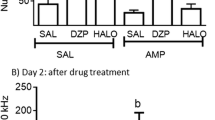Abstract
The role of the amygdala in the anxiolytic action of benzodiazepines was examined. Performance on a water-licking conflict paradigm was tested in rats with localized damage to the central nucleus of the amygdala (ACE) or with general damage to the entire amygdaloid complex. The effects of the benzodiazepine chlordiazepoxide (2.5–20.0 mg/kg) on conflict behavior in these animals was also examined. Electrolytic lesions of either ACE or of the entire amygdaloid complex resulted in a pronounced increase of punished responding, an effect that persisted for at least 12 sessions postoperatively. After shock levels were adjusted in the lesioned groups to match their baseline punished behavior to that of the controls, various doses of chlordiazepoxide were administered. Not only did the lesioned animals show an increase in punished behavior in response to the drug, they were more sensitive than controls to the lower drug doses. A complete model of anxiolytic action may have to include both mechanisms that block anxiogenic regions and those that activate anxiolytic regions.
Similar content being viewed by others
References
Blanchard DC, Blanchard RJ, Lee EM, Nakamura S (1979) Defensive behavior in rats following septal and septal-amygdala lesions. J Comp Physiol Psychol 93:378–390
Cormier SM (1981) A match-mismatch theory of limbic system function. Physiol Psychol 9:3–36
Costall B, Kelly ME, Naylor RJ, Onaivi ES, Tyers MB (1989) Neuroanatomical sites of action of 5-HT3 receptor agonist and antagonist for alteration of aversive behavior in the mouse. Br J Pharmacol 96:325–332
Davis M, Hitchcock JM, Rosen JB (1987) Anxiety and the amygdala: Pharmacological and anatomical analysis of the fearpotentiated startle paradigm. In: Bower GH (ed) The psychology of learning and motivation, vol 21. Academic Press, New York, pp 265–305
Geller I, Seifter J (1960) The effects of meprobamate, barbiturates,d-amphetamine and promazine on experimentally induced conflict in the rat. Psychopharmacologia 1:482–492
Gray JA (1982) The neuropsychology of anxiety. Oxford University Press, New York
Grishkat H, Thomas E (1988) Conflict behavior in rats with lesions of the amygdala, the mammillary bodies, locus coeruleus, and dorsal raphe. Neurosci Abstr 14:923
Guzman-Flores CM, Alcarez M, Fernandez-Guardiola A (1958) Rapid procedure to localize electrodes in experimental neurophysiology. Boletin del Instituto de Estudios Medicos y Biologicos (Mexico) 16:26–31
König JFR, Klippel RA (1963) The rat brain: a stereotaxic atlas. Williams and Wilkins, Baltimore
McCown TJ, Vogel RA, Breese GR (1983) An efficient chronic conflict paradigm: lick suppression by incremental footshock. Pharmacol Biochem Behav 18:277–279
Nagy J, Zambo K, Desci L (1979) Antianxiety action of diazepam after intra-amygdaloid application in the rat. Neuropharmacology 18:573–576
Niehoff DL, Kuhar MJ (1983) Benzodiazepine receptors: localization in rat amygdala. J Neurosci 3:2091–2097
Rosen JB, Davis M (1988) Enhancement of acoustic startle by electrical stimulation of the amygdala. Behav Neurosci 102:195–202
Scheel-Kruger J, Petersen EN (1982) Anticonflict effect of the benzodiazepines mediated by a GABAergic mechanism in the amygdala. Eur J Pharmacol 82:115–116
Shibata K, Kataoka Y, Yamashita K, Ueki S (1986) An important role of the central nucleus and mammillary body in the mediation of conflict behavior in rats. Brain Res 372:159–162
Soubrié P (1986) Reconciling the role of central serotonin neurons in human and animal behavior. Behav Brain Sci 9:319–364
Thiébot MH, Hamon M, Soubrié P (1982) Attenuation of induced anxiety in rats by chlordiazepoxide: role of raphe dorsalis benzodiazepine sites and serotonergic neurons. Neuroscience 7:2287–2294
Thiébot MH, Hamon M, Soubrié P (1983) The involvement of nigral serotonin innervation in the control of punishment-induced behavioral inhibition in rats. Pharmacol Biochem Behav 19:225–229
Thiébot MH, Soubrié P, Hamon M, Simon P (1984) Evidence against the involvement of serotonergic neurons in the antipunishment activity of diazepam in the rat. Psychopharmacology 52:355–359
Thomas E (1988) Forebrain mechanisms in the relief of fear: the role of the septum. Psychobiology 16:36–44
Usher DR, Lieblich I, Siegel RA (1974) Pituitary-adrenal function after large and small lesions in the lateral septal area in food-deprived rats. Neuroendocrinology 16:156–164
Vogel JR, Beer B, Clody DE (1971) A simple and reliable conflict procedure for testing antianxiety agents. Psychopharmacologia 21:1–7
Wise CD, Berger BD, Stein L (1972) Benzodiazepines: Anxiety-reducing activity by reduction of serotonin turnover in the brain. Science 117:180–183
Yadin E, Thomas E (1991) The lateral septum as an anxiety-inhibiting structure: a new model for anxiolytic action. In: Briley M, File S (eds) The Pierre Fabre Monograph Series, vol 4. Macmillan Press New York in press
Yadin E, Thomas E, Strickland CE (1987) Effects of anxiolytic agents on conflict behavior in animals with septal or amygdaloid lesions. Neurosci Abstr 13:454
Author information
Authors and Affiliations
Rights and permissions
About this article
Cite this article
Yadin, E., Thomas, E., Strickland, C.E. et al. Anxiolytic effects of benzodiazepines in amygdala-lesioned rats. Psychopharmacology 103, 473–479 (1991). https://doi.org/10.1007/BF02244247
Received:
Revised:
Issue Date:
DOI: https://doi.org/10.1007/BF02244247



